
|
|
June 19-26, 2002
Nashville: More from Music City
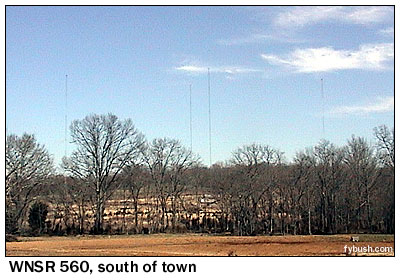 Our late February
- early March excursion to the mid-South began and ended in the
same place: Nashville, Tennessee. On the way out of town, we
saw just one station: WSM, which
merited its very own episode of Tower Site of the Week.
Our late February
- early March excursion to the mid-South began and ended in the
same place: Nashville, Tennessee. On the way out of town, we
saw just one station: WSM, which
merited its very own episode of Tower Site of the Week.
A few days later, we returned under sunnier skies to see what else the Music City had in store for us, beginning at the far southern end of the market. WNSR (560) is Nashville's all-sports station, licensed to suburban Brentwood and operating from these four towers, back there in the brush off North Chapel Road, north of Tennessee 96 and east of Franklin.
From here, we head back to I-65 and north to the WSM exit for a few nice blue-sky pictures of that beautiful site - and then it's off to see Nashville itself!
From the WSM tower, you can look north and west to see several very tall TV and FM towers, carrying with them an interesting history linked to Nashville's third TV station. WSIX-TV came along after the big guys, NBC affiliate WSM-TV (now WSMV, channel 4) and CBS affiliate WLAC-TV (now WTVF, channel 5), and struggled for years with a higher dial position (channel 8), weaker affiliation (ABC) and fuzzier signal in town.

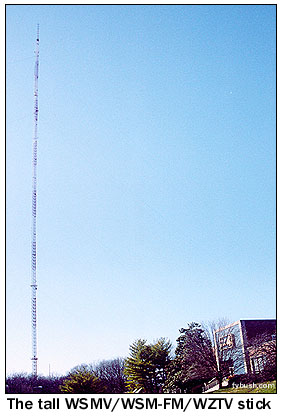 In 1973, WSIX-TV
found a solution of sorts: it traded its channel 8 facility to
the market's public broadcaster, WDCN, in exchange for channel
2, right there at the start of the dial.
In 1973, WSIX-TV
found a solution of sorts: it traded its channel 8 facility to
the market's public broadcaster, WDCN, in exchange for channel
2, right there at the start of the dial.
New owner General Electric changed channel 2's calls to WNGE - but the change didn't really help the ratings. Neither did a sale to Knight-Ridder a few years later that turned the station into its current incarnation, WKRN. (In fact, the station still lags WSMV and WTVF in the ratings even now.)
In any event, these two towers just north of Old Hickory Road are WKRN on channel 2 and the PBS outlet on channel 8, now known as WNPT ("Nashville Public Television"), and still shared with WSIX-FM (97.9), the market's country radio giant.
Just across Old Hickory Road is another tall tower, home to several other big FM signals: public radio WPLN (90.3), country WKDF (103.3) and rocker WNRQ (105.9), as well as lower-powered AAA station WRLT (100.1).
We detour from here to enjoy a really good country lunch at the famed Loveless Cafe down on Tennessee 100, south of Belle Meade (highly recommended - try the biscuits and the strawberry preserves!), then get back to business hunting steel, beginning with the other big southside TV/FM stick.
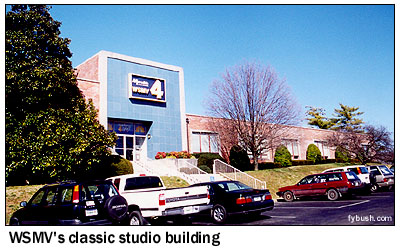

The former WSM-TV sits atop a hill off Knob Road, southeast of downtown, with a big tower that carries WSM-FM (95.5), WNPL (106.7 Belle Meade), Vanderbilt University's WRVU (91.1) and Fox affiliate WZTV (Channel 17) as well as WSMV itself.
Channel 4 still lives in this nice-looking brick building up on the hill, which was once home to the WSM radio studios as well. Today, channel 4 is a Meredith station, and it's still a market leader.
From WSMV, we head up Tennessee 155 (the locals call it "Briley Parkway"), across the Cumberland River to Hyde's Ferry Pike (aka route 12), where we see four towers up on the hill west of the interchange. These were once Nashville's 1560 facility, which is today WMRO, licensed to Gallatin and operating from a new site to the north. After years of sitting here unused, the sticks (well, one of them, anyway) were reactivated in early 2002 for the long-dormant Nashville 1200 CP.
When we visited, 1200 was WQDQ, simulcasting Spanish programming from WKDA on 1430; a few weeks later, the WKDA calls and format moved down the dial to 1200.
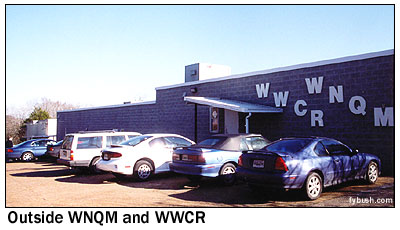
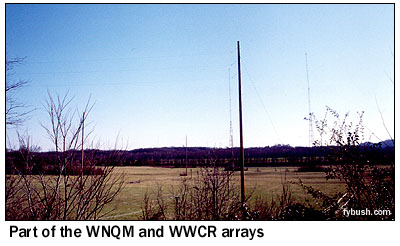
But we were aimed for another site just down Hyde's Ferry Road, reached by a twisty dirt road labeled "WWCR Avenue": the home of religious WNQM (1300) and shortwave station WWCR, "World Wide Christian Radio." It's of particular interest because your editor has been involved for years with the "Spectrum" communications magazine show that's aired on Saturday nights over WWCR's #3 transmitter.
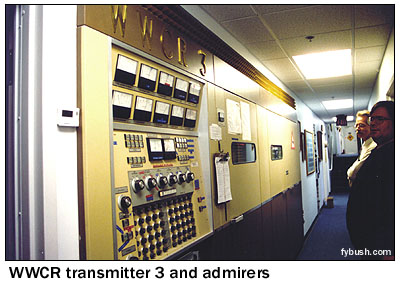 Adam Locke runs the
place, and that's him under the light in the photo at left. The
other guy? Well, now you all know what tower-hunter Garrett Wollman
looks like...
Adam Locke runs the
place, and that's him under the light in the photo at left. The
other guy? Well, now you all know what tower-hunter Garrett Wollman
looks like...
In any case, two of WWCR's four Continental 500 kW transmitters, along with the WNQM transmitter (a newish Continental 50 kW rig) all line a hallway of the main WNQM/WWCR building, along with studios and offices for handling all the many programs that come in by tape.
The other two WWCR transmitters live in the little white building at the far left of the photo above. One runs Dr. Gene Scott's University Network 24/7; the other runs Brother Stair. Hey, it pays the bills!
WNQM is the old WMAK, which was once Nashville's top-40 station. A fire here destroyed nearly all of the WMAK legacy a few years back, leaving just a charred survey sheet that's now framed and hanging in one of the studios. WNQM recently upgraded to 50 kW by day, with a signal that shoots north with so much strength that we had no trouble hearing it in morning daylight in Charleston, W.V. a few months ago!
WNQM's towers are five in a line (you see two of them above); WWCR's rhombus antennas are strung from a small forest of telephone poles out there in the swamp behind the station.
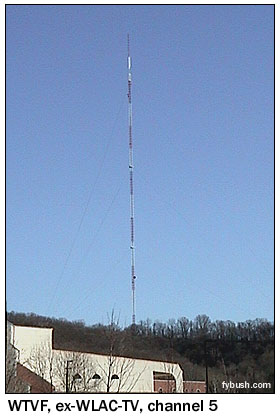
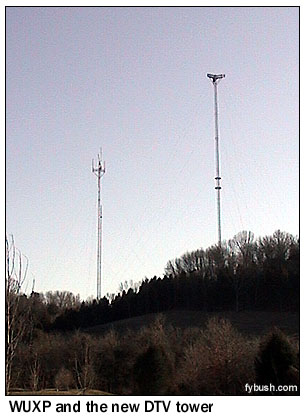 From
here, we skirted the north end of the market, heading around
Briley Parkway (which forms a loop around the north side of the
city) to I-24, then one exit north to Old Hickory Boulevard (Tennessee
45), which offers sightlines to the other tall TV towers in town.
From
here, we skirted the north end of the market, heading around
Briley Parkway (which forms a loop around the north side of the
city) to I-24, then one exit north to Old Hickory Boulevard (Tennessee
45), which offers sightlines to the other tall TV towers in town.
Shown at left is the one just east of I-24, home to WTVF (Channel 5) and WGFX (104.5); at right is the one west of I-24 that's home to UPN affiliate WUXP (Channel 30), oldies WMAK (96.3) and hot AC WRVW (107.5).
Under construction just next door is a new tower for DTV use, if memory serves.
From here, it's just a short ride east on Old Hickory to channel 5's former radio partner, Nashville's other big 50 kilowatt AM signal. WLAC has been out here since the thirties, when the station was operating on 1470. Since 1941, it's been a clear channel signal on 1510, and you've probably heard it more than once, pumping out news, talk and paid religion over most of the East after dark.
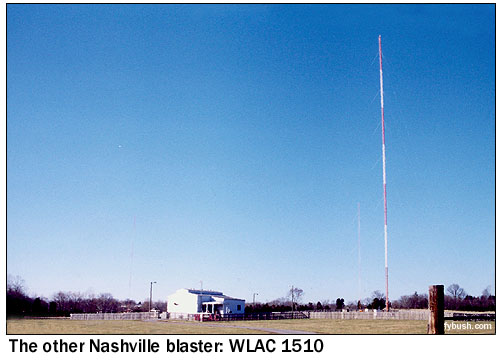 The big tower in
the foreground is the day tower, of course; you need to look
very carefully just to the left of the day tower and just to
the left of the light pole next to the transmitter building to
see the other two towers that make up the night array, protecting
KGA way out there in Spokane.
The big tower in
the foreground is the day tower, of course; you need to look
very carefully just to the left of the day tower and just to
the left of the light pole next to the transmitter building to
see the other two towers that make up the night array, protecting
KGA way out there in Spokane.
Look closely in front of the building and you can just make out big red letters that spell out "WLAC," too!
From here, it was off to Nashville's other "clear channel" AM signal, as well as some of the smaller ones - and then to the downtown studios and Music Row. But for that, you'll have to come back next week, as we present part two of our Music City trip! See you then...
- Previous Site of the Week: Huntsville, Alabama
- Next Week: Nashville, Tennessee, part two
- How can you help support Site of the Week? Click here!
- Submit your suggestions for a future Site of the Week!
